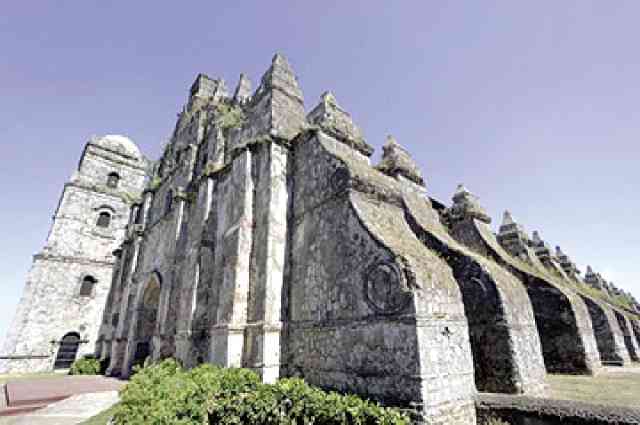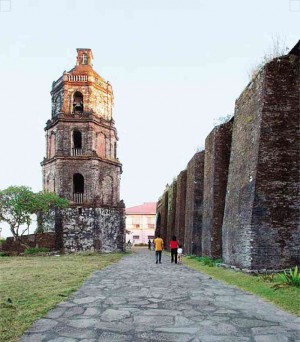
Colonial churches were built by the great Catholic friar missionary orders with the best available European technology of their day. The technology remains valid today
The answer is no.
Contrary to what armchair theorists claim, the lack of steel reinforcement is not the reason why heritage structures collapsed during the recent earthquakes and typhoons.
Nor should the collapsed structures be reinforced with steel when they are reconstructed.
They should be reconstructed either in the same way that they were originally constructed, or, if that is not possible, in a manner totally compatible with how they were originally built.
This is a requirement taken with contention and misunderstanding by architects and engineers (and also by government and church authorities) who are unaware of conservation procedures.
We no longer build with stone these days.

Since its introduction in the latter half of the 19th century, concrete construction revolutionized the building industry. However, concrete is a composite construction material that, unlike stone, cannot be used alone and requires steel reinforcement to provide added strength.
But many varieties of stone have the inherent strength to be used alone without any reinforcement by another material as needed by concrete.
How were large churches and houses constructed during the Spanish colonial era without any steel?
Introduction of masonry
The introduction of stone and masonry construction in the Philippines is attributed to Antonio Sedeño, a Jesuit who was among the earliest missionaries to arrive in the Philippines in 1581.
The Spanish Dominican historian and University of Santo Tomas professor, Fr. Pablo Fernandez OP, author of “History of the Church in the Philippines” (1979), wrote that Sedeño had “knowledge of quarrying [and] finishing stone, erecting arches, and measuring distances. [His] work was copied by others and carried throughout the archipelago.”
Exterior church walls were built of large stone blocks laid in alternate rows for added strength. Rows were placed one on top of the other and fastened together by mortar made of natural materials.
The actual mix for mortar varies depending on natural materials available. It can be either a glue-like paste of natural lime mixed with egg white, or a mix thickened with sticky juices extracted from plants (such as maguey plants used in Vigan) and further strengthened by mixing in plant fibers.

A system of vertical supports provides stability to the structure. Situated at each corner and along regular intervals running the length of the walls, vertical columns built up larger, thicker stone blocks provide vertical support to the walls and hold up the roof.
Stone columns and walls, thick enough to provide needed strength to hold up both the structure and roof, interact to keep the entire structural system balanced, stable and in equilibrium.
Most dramatic buttresses
Continuing an ancient construction technique developed by the Romans, the great Catholic friar missionary builders such as the Augustinians, Franciscans, Dominicans and Recollects, used stone arches to frame the tops of openings and to evenly distribute the weight of the wall above doors, windows and other openings to prevent them from collapse.
A system of stone buttresses, exterior supports built vertically at right angles to the walls, provide added strength to prevent the high walls from falling, especially when buffeted by strong wind and during tremors.
The most dramatic exterior buttresses are seen in the Church of San Agustin in Paoay (Ilocos Norte), built by the Augustinians. It is inscribed on the Unesco World Heritage List.
At San Agustin Church in Intramuros, also inscribed on the World Heritage List, the buttress system is inside the church, unlike Paoay’s which is outside.
The buttresses strengthening the high walls of San Agustin Church, also built by the Augustinians, are thick walls attached at right angles to the inside face of the exterior wall.
Spaced at regular intervals, the internal buttresses extend a short distance from the outside wall to the edge of the nave (the large, unobstructed interior space where devotees attend religious services). To camouflage the thickness of the buttresses, the spaces between them have been made into a series of small chapels.
Underground raft
Making San Agustin even more outstanding is that the foundations that support the entire church float on an underground raft of logs that allow the massive structure to sway gently to resist damage caused by tremors.
Another distinctly Philippine approach to earthquake protection is the construction of bell towers at a distance away from the main church structure, a pragmatic response to the destruction of churches caused by towers attached to their façades falling on the structure during an earthquake.
Colonial churches were built with the best available technology of their day, a European-based technology that fully understood the technique of building with stone.
If the churches are to be restored, then they should be reconstructed in the same manner and with the same technology with which they were originally built.
Of course, newer technology can be incorporated into the structure. However, it must be certain that the new technology is totally compatible with the original construction methods and materials, or else all authenticity will be lost.
An example of incompatibility of new and old construction material would be using steel-reinforced concrete to repair old churches that were constructed of either volcanic or coral stone and lime mortar. The acids in concrete react violently with lime, ultimately causing more destruction to the structure.
How did these heritage structures remain standing for centuries, and why did the recent disasters cause many of them to collapse?
Members of the Association of Structural Engineers of the Philippines answered that question at a forum organized by the International Council of Monuments and Sites Philippines and the National Museum. Their presentation will be the topic of a future column.
E-mail the author at [email protected].













































